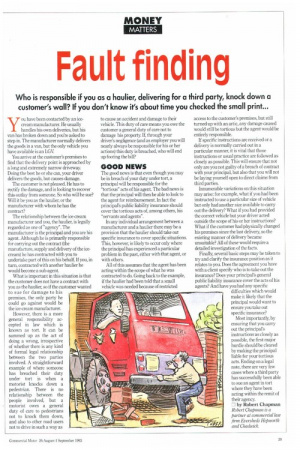Fault finding
Page 31

If you've noticed an error in this article please click here to report it so we can fix it.
you have been contacted by an icecream manufacturer. He usually handles his own deliveries, but his van has broken down and you're asked to step in. The manufacturer normally delivers the goods in a van, but the only vehicle you have available is an LGV
You arrive at the customer's premises to find that the delivery point is approached by a long and extremely narrow driveway Doing the best he or she can, your driver delivers the goods, but causes damage.
The customer is not pleased. He has to rectify the damage, and is looking to recover this outlay from someone. So who will he sue? Will it be you as the haulier, or the manufacturer with whom he has the contract?
The relationship between the ice-cream manufacturer and you, the haulier, is legally regarded as one of "agency". The manufacturer is the principal and you are his agent. Although he is primarily responsible for carrying out the contract (the manufacture, supply and delivery of the icecream) he has contracted with you to undertake part of this on his behalf. If you, in turn, contracted with another haulier he would become a sub-agent.
What is important in this situation is that the customer does not have a contract with you as the haulier, so if the customer wanted to sue for damage to his premises, the only party he could go against would be the ice-cream manufacturer.
However, there is a more general responsibility accepted in law which is known as tort. It can be summed up as the act of doing a wrong, irrespective of whether there is any kind of formal legal relationship between the two parties involved. A straightforward example of where someone has breached their duty under tort is when a motorist knocks down a pedestrian. There is no relationship between the 'people involved, but a motorist owes a general duty of care to pedestrians not to knock them down, and also to other road users not to drive in such a way as to cause an accident and damage to their vehicle. This duty of care means you owe the customer a general duty of care not to damage his property. If, through your driver's negligence (and as employer you will nearly always be responsible for his or her actions) this duty is breached, who will end up footing the bill?
The good news is that even though you may be in breach of your duty under tort, a principal will be responsible for the "tortious" acts of his agent. The bad news is that the principal will then be able to look to the agent for reimbursement. In fact the principal's public liability insurance should cover the tortious acts of, among others, his "servants and agents".
In any individual arrangement between a manufacturer and a haulier there may be a provision that the haulier should take out specific insurance to cover specific situations. This, however, is likely to occur only where the principal has experienced a particular problem in the past, either with that agent, or with others.
All of this assumes that the agent has been acting within the scope of what he was contracted to do. Going back to the example, if the haulier had been told that a small vehicle was needed because of restricted access to the customer's premises, but still turned up with an artic, any damage caused would still be tortious but the agent would be entirely responsible.
If specific instructions are received or a delivery is normally carried out in a particular manner, it is vital that those instructions or usual practice are followed as closely as possible. This will ensure that not only are you not guilty of a breach of contract with your principal, but also that you will not be laying yourself open to direct claims from third parties.
Innumerable variations on this situation may arise: for example, what if you had been instructed to use a particular size of vehicle but only had another size available to carry out the delivery? What if you had provided the correct vehicle but your driver acted outside the scope of his or her instructions? What if the customer had physically changed his premises since the last delivery, so the existing manner of delivery became unsuitable? All of these would require a detailed investigation of the facts.
Finally, several basic steps may be taken to try and clarify the insurance position as it relates to you. Does the agreement you have with a client specify who is to take out the insurance? Does your principal's general public liability insurance cover the acts of his agents? And have you had any specific difficulties which would make it likely that the principal would want to ensure you take out specific insurance?
Most importantly, by ensuring that you carry out the principal's instructions as closely as possible, the first major hurdle should be cleared by making the principal liable for your tortious acts. Ending on a legal note, there are very few cases where a third party has successfully been able to sue an agent in tort where they have been acting within the remit of their agency.
by Robert Chapman Robert Chapman is a partner at commercial Law firm Eversheds Hepworth and Chadwick.












































































